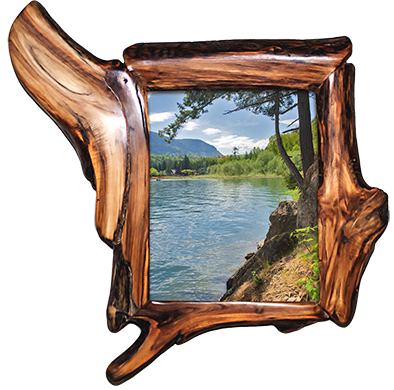The Difference Between Composition and “Framing” a Photograph
Are Framing a Photograph and Composition Different?
It is tricky to define the difference between composition and framing a photograph in terms of photography, because the terms definitely overlap. Let’s talk about what the two terms mean first, starting with framing a photograph, or “framing the shot”.
10 Unique Framing Ideas – Creative Picture Framing
Framing a Photograph
The act of “framing” a photograph (we’re obviously not talking about picture frames here – at least not yet…!) can say a lot about the photographer and their intentions, preferences, and perspective. Here are some possible interpretations:
- Attention to Detail: Framing a photograph shows that the photographer pays attention to the details within the scene. They carefully consider what elements to include or exclude from the frame to create a visually pleasing composition.
- Intentionality: It suggests that the photographer has a specific intention or message they want to convey through the photograph. They may use framing to emphasize certain subjects, emotions, or narratives within the image.
- Creativity and Vision: Framing a photograph can reflect the photographer’s creativity and unique vision. They may experiment with different perspectives, angles, and compositions to create images that stand out and evoke a strong response from viewers.
- Personal Style: The way a photographer frames their photographs can also reveal aspects of their personal style and aesthetic preferences. Some photographers may prefer tight, close-up compositions, while others may favor more expansive, wide-angle shots.
- Emotional Connection: Framing a photograph can indicate an emotional connection to the subject matter or scene. The photographer may choose to frame a photograph in a way that captures the essence of a moment or evokes a specific mood or feeling.
- Technical Skill: A well-framed photograph demonstrates the photographer’s technical skill in terms of understanding composition, lighting, and perspective. It shows that they have the ability to translate their creative vision into a cohesive and visually appealing image.
Craig’s Unique Home Page Craig’s Very Tall Tales
 Overall, framing a photograph is a deliberate and expressive act that allows the photographer to communicate their perspective and interpretation of the world around them. It’s a way of capturing moments, stories, and emotions through the lens of their own unique vision.
Overall, framing a photograph is a deliberate and expressive act that allows the photographer to communicate their perspective and interpretation of the world around them. It’s a way of capturing moments, stories, and emotions through the lens of their own unique vision.
Composition of a Photograph
The composition of a photograph refers to how the various elements within the image are arranged and organized. It encompasses factors such as the placement of subjects, lines, shapes, colors, textures, and negative space within the frame. A well-composed photograph effectively uses these elements to create a visually appealing and balanced image that draws the viewer’s attention and conveys the intended message or emotion.
Why is composition important in photography?
Some Key Aspects of Composition in Photography:
- Rule of Thirds: This is a fundamental principle where the frame is divided into a grid of nine equal sections using two horizontal and two vertical lines. Placing key elements along these lines or at their intersections can create a more dynamic and visually pleasing composition.
- Balance: Achieving balance in composition involves distributing visual weight evenly across the frame. This can be done through the arrangement of subjects, colors, and shapes to create a sense of equilibrium.
- Leading Lines: Lines within the photograph that lead the viewer’s eye towards a focal point or through the image can help create a sense of depth and guide the viewer’s attention.
- Symmetry and Asymmetry: Symmetrical compositions have elements that are evenly balanced on either side of the frame, while asymmetrical compositions create balance through the careful arrangement of unequal elements.
 Foreground, Midground, and Background: Effective composition often involves creating depth by including elements in the foreground, midground, and background of the image, which can add visual interest and dimension. Understanding Depth of Field – A Beginner’s Guide
Foreground, Midground, and Background: Effective composition often involves creating depth by including elements in the foreground, midground, and background of the image, which can add visual interest and dimension. Understanding Depth of Field – A Beginner’s Guide- Framing and Cropping: How the photographer frames the scene within the camera’s viewfinder or crops the image afterward can significantly impact the composition and overall feel of the photograph.
- Color and Contrast: The use of color and contrast can also play a vital role in composition, as they can help create visual interest, highlight important elements, and evoke certain emotions.
- Negative Space: Negative space refers to the areas around the main subjects in the photograph. Including adequate negative space can help to emphasize the subjects and create a sense of balance and clarity in the composition.
Overall, composition is a critical element of photography that can greatly influence the effectiveness and impact of an image. By carefully considering and manipulating these compositional elements, photographers can create images that are not only visually appealing but also convey their intended message or story effectively.
Framing a Shot and Composition
Are Framing and Composition the Same Thing?
Why Is Custom Framing So Expensive?
 Framing a photograph and composition are closely related but not exactly the same. Here’s how they differ:
Framing a photograph and composition are closely related but not exactly the same. Here’s how they differ:
- Framing a Shot: Framing a shot refers to the physical act of selecting what to include within the boundaries of the photograph. It involves decisions about what to include or exclude from the frame and how to position the camera to capture the desired scene or subject. Framing also includes considerations such as the angle, perspective, and distance from the subject.
- Composition: Composition, on the other hand, encompasses the arrangement and organization of elements within the frame. It involves decisions about the placement of subjects, lines, shapes, colors, textures, and negative space to create a visually appealing and balanced image. Composition focuses on the overall structure and visual relationships within the photograph.
While framing a shot is a part of the process of composition, composition involves a broader set of considerations beyond just what is included in the frame. It involves the arrangement and manipulation of elements within the frame to create a cohesive and impactful image. Therefore, framing is a component of composition, but composition encompasses a wider range of artistic decisions and techniques.
12 Amazing Composition Techniques and Tips
Effectively Framing a Shot in Photography
As we discussed early on, framing a shot in photography essentially involves the process of selecting and positioning elements within the viewfinder or frame of the camera to create a visually pleasing composition. Here’s a step-by-step guide on how to frame a shot effectively:
- Identify Your Subject: Decide what you want to be the main focus of your photograph. This could be a person, object, landscape, or anything else that you want to capture.
- Consider the Background: Pay attention to the background of your shot. Look for clean, uncluttered backgrounds that won’t distract from your subject. Avoid elements that may be visually jarring or take attention away from your main subject.

- Position Your Subject: Place your subject within the frame of your camera. Consider using the rule of thirds to position your subject off-center, which can create a more dynamic composition. Experiment with different placements to find the most visually appealing arrangement.
- Frame Your Subject: Look for natural or man-made elements in the scene that can be used to frame your subject. This could include doorways, windows, arches, trees, or other objects that create a natural frame around your subject. Position your subject within the frame to draw attention to it and create a sense of depth.
- Pay Attention to Lines and Shapes: Consider the lines, shapes, and patterns within your scene. Look for leading lines that can guide the viewer’s eye toward your subject and add visual interest to your composition. Use geometric shapes and patterns to create a sense of rhythm and balance within the frame.
- Experiment with Perspective: Try shooting from different angles and perspectives to find the most compelling composition. Get down low or shoot from above to change the viewer’s perspective and create unique compositions. Consider using a wide-angle lens to capture more of the scene or a telephoto lens to isolate your subject and create a shallow depth of field.
- Review and Refine: Take the time to review your composition through the viewfinder or LCD screen. Pay attention to details such as cropping, distractions, and overall balance. Make any necessary adjustments to refine your composition before taking the shot.
- Capture the Shot: Once you’re satisfied with your composition, press the shutter button to capture the shot. Be mindful of your exposure settings, focus, and any other technical considerations to ensure that you achieve the desired result.
 By following these steps and practicing your framing skills, you can learn to frame a photograph effectively and create visually compelling photographs that resonate with an audience. Don’t be afraid to experiment and try new techniques to find your unique style as a photographer.
By following these steps and practicing your framing skills, you can learn to frame a photograph effectively and create visually compelling photographs that resonate with an audience. Don’t be afraid to experiment and try new techniques to find your unique style as a photographer.
Essential Knowledge for Better Photos
Framing a Photograph with a Physical Frame
How a photograph is framed from a photography standpoint is crucial to how the photo will look. But a great photograph will be worthy of and in need of a physical frame to showcase and compliment it. And you should probably get a really awesome one.
I can sell you one, if you like. 😎 Craig’s Unique Etsy Shop
There is “framing” a photograph, and then there is framing a photograph. The thought I had before writing this article was that maybe having a better understanding of one will give you a better idea of how to do the other, whether you are an aspiring photographer or not.
Either way, happy framing!
Craig’s Unique Home Page What Is the Purpose of a Picture Frame?
Build Your Own One-of-a-Kind Wood Frames | DIY Unique Picture Frames
Why Custom Wood Picture Frames Are So Popular as Gifts
10 Unique Framing Ideas – Creative Picture Framing
